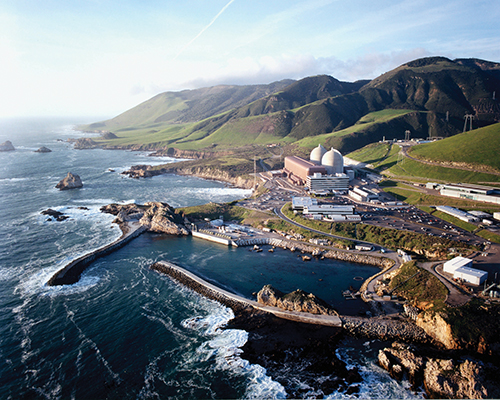A split County Board of Supervisors approved a Resolution of Support for the Diablo Canyon Nuclear Power Plant to remain open another 20 years.
It’s the latest rebound of an issue that’s been kicked around more than a soccer ball at recess, as the plant had been on a path for a new license, until it suddenly wasn’t and local activists celebrated it’s eminent demise.
But then Mother Nature played a cruel trick and exposed the State’s lack of replacement power for the reliable 2,200-megawatts the plant delivers. Rolling brownouts and power shortages led State officials to second-guess the closure.
Acting County Administrator, Rebecca Campbell brought the Diablo Canyon Resolution back to the Board, which had authorized the writing of the document at its Feb. 27 meeting.
Indeed, in March 2021, Pacific Gas & Electric began a multi-billion dollar decommissioning process, submitting a land use permit application.
The County deemed the application complete in October 2021 and work began on a draft Environmental Impact Report. The DEIR was released for comments in July 2023, with some 37 letters being submitted for inclusion.
Currently, the County and EIR consultant are formulating responses to each of those letters and a final decommissioning EIR is expected to be released in August for approval.
But that process won’t likely go any further, since the efforts to close Diablo Canyon, the State’s last operating nuclear plant, have made a 180-degree turn. Now, the government’s efforts are going to keep it open, a move that has long-time opponents in an uproar.
“Given the extreme heat waves and wildfires California has experienced in recent years,” reads Campbell’s report, “the state’s transition from fossil fuel electricity generation to clean energy sources, and energy supply projections, Senate Bill (SB) 846 was signed into law in September 2022, providing a path toward extending the operations of the DCPP. Since this path was not guaranteed, PG&E requested that the County continue with preparing the DCPP decommissioning EIR and permitting.”
The State was looking for the plant to remain open for another five years, and PG&E agreed to do that, after the State approved a $1.4 billion loan guarantee to help pay for keeping the plant operating. That money would be available if the Federal Government failed to grant an award to PG&E out of the Department of Energy’s “Civil Nuclear Credit Program.” The Energy Department did grant $1.1 billion in January, leaving the State to presumably pick up the shortfall.
PG&E had sought to pick up with its licensing application that was abandoned when the decision as made to close, but the NRC said it had to start over with a new licensing application, and it would be for a 20-year extension, not the 5 years that had been requested.
That process is well underway with an NRC committee of staffers holding public meetings on what would be an “Environmental Impact Statement” (the federal environmental review process).
Now the NRC is expected to decide on the new license application in August 2025.
While it is working on staying open another two decades, it’s also working on the eventual closure of the plant and reuse of the roughly 12,000 acres that surround the plant.
Another effort is being made along those lines with a Decommissioning Panel” PG&E set up with ordinary citizens manning the board.
Among the critics of the Resolution was local 17th District State Sen. John Laird, who drafted a letter to the Supervisors on official State Senate stationary.
In it, Sen. Laird, who helped negotiate SB 846, sought to educate the Supervisors on its provisions.
Sen. Laird wrote, “Specifically, the major provisions of SB 846 include the following:
• Required that San Luis Obispo County communities that received $85 million in mitigation funding and PG&E employees who benefitted by a $350 million retention and retraining program based on the former closing date of 2025 (as authorized under SB 1090 – 2018) do not have to return those funds, in light of the limited, five-year extension;
• Required seismic and other safety review processes so that the continued safety of workers and surrounding residents would be considered in the extension of an aging facility;
• Required that the financing process around the state loan for the extension process have very limited exposure to utility ratepayers and state taxpayers;
• Required a regular California Coastal Commission approval of the extension, with the time for that process limited;
• Provided a process and funding for the protection of and public access to the Diablo Canyon Lands, which surround the plant;
• Limited the extension to 2030 to allow for the use of transmission for the energy generated by offshore wind at the Morro Bay Wind Energy Area;
• Provided for the purchase of fuel in a timely manner to meet the extended plant life; and
• Set forth provisions about maintenance of facilities; planning for economic reuse of the Parcel P section of the plant; raised the once-through-cooling fee with an eye to certain expenses; and provided one billion dollars over three years for additional renewable electricity development in California.”
Of note, that offshore floating wind energy project is itself starting to face growing opposition form local residents, who oppose industrialization of the ocean with giant windmills floating offshore from San Simeon.
Also, the three companies that won lease sites here, have watched cost estimates for wind farms off the East Coast skyrocket in recent years.
It remains to be seen if the floating wind turbine projects will ever be built and making room for wind energy on the local high voltage transmission lines might be a moot point.
Sen. Laird added that these different SB 846 requirements are currently in various stages of completion. Sen. Laird cited:
• The safety analysis will not be completed until the embrittlement of Unit 1 can be tested, which will not be done until 2025, with the results available no earlier that 2026;
• While the loan has been approved at the federal level, it does not reach the level expected to cover all costs of plant extension, and the risk to the taxpayers and ratepayers must still be protected, especially at a time when PG&E rates are going through the roof across California;
• PG&E’s application to the California Coastal Commission for a Consistency Certification (under the Coastal Zone Management Act) has not been completed, and the conditions of the consistency determination, and of a coastal development permit, have not been developed nor implemented;
• The federal government has issued three leases for offshore wind in the Morro Bay Wind Energy Area since SB 846 was enacted, and the process of involving different stakeholders and attempting to resolve differences has only just begun;
• The once-through-cooling fee issues have not been resolved; and,
• The process for reviewing options for the Diablo Canyon Lands is underway but is at the early stages.
In sum, Sen. Laird believes the Supervisors’ Resolution comes too early.
“In short,” he wrote, “many of the issues that might be involved in an additional 15-year extension have not even been resolved yet for the five-year extension set forth in SB 846. Therefore, it is clear that any discussion of an extension beyond what was enacted with SB 846 is very premature.”
He noted that if the plant stays open, the monies allocated for “transition pay for workers,” would come into question.
He pointed out that the State Legislature and Gov. Newsom have so far only supported five more years of operations, not 20.
“As a state legislator from this region,” Sen. Laird concluded, “I would certainly not support any legislation for a further extension until the extension we have already approved is fully permitted, and all the attending issues outlined above are fully considered and addressed.”
The three-page Resolution lists several “Whereas” items, among them: “Diablo Canyon Nuclear Power Plant (DCPP), California’s last operating nuclear power plant, is located in San Luis Obispo County and has operated safely since 1985 under the U.S. Nuclear Energy Commission, which protects public health and safety and has the authority to shut down DCPP, if there is any concern;” and, “DCPP is California’s largest clean energy generator, operating 24 hours per day, 365 days a year, rain or shine; and is the County’s largest private employer with 1300 head-of-household jobs, and also provides millions of dollars in annual property taxes for our children’s schools.”
And this, “San Luis Obispo County respectfully requests that the State of California give strong consideration to extending the DCPP operational lifespan up to 20 more years. Doing so offers certainty, ensures material forecasting, assists workforce planning, drive down costs and together with renewables, DCPP enhances grid stability and energy security for all our families and communities.”
As with everything about Diablo Canyon, the Resolution brought a lot of people to the Supervisors’ Chambers and the debate was as evenly split as the Supervisors’ vote, 3-2, with Jimmy Paulding (Dist. 4) and Bruce Gibson (Dist. 2) voting against the Resolution.
Dist. 3 Supervisor, Dawn Ortiz-Legg who has Diablo Canyon within her district was the swing vote, as the liberal Democrat voted against the other two Dems on the Board — Gibson and Paulding.
Dist. 1’s John Peschong and Dist. 5’s Debbie Arnold joined Ortiz-Legg in support.
Ortiz-Legg, who used to work for PG&E, has long been in support of keeping the plant open past the licenses expirations, as many of the head-of-household jobs holders live in Dist. 3.



